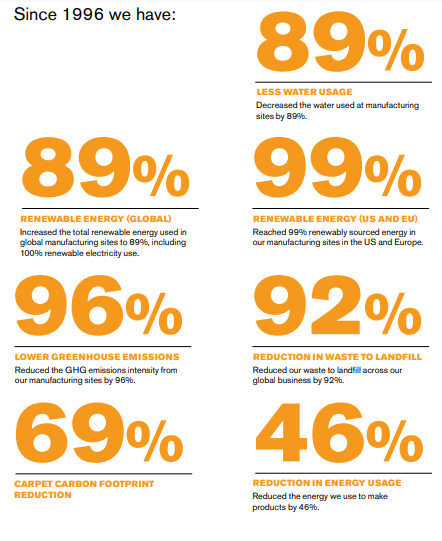Interface achieves Mission Zero Success early; creates road map for other companies


Interface announced in early November it has hit Mission Zero ahead of its original 2020 target. Over the past 25 years, the company drove significant improvements across all key sustainability metrics internally and throughout its supply chain to help meet its objectives. And, Interface galvanized others along the way to implement more sustainable business practices. This created a positive ripple effect that helped the company not only achieve but also extend Mission Zero far beyond its original intentions.
Interface’s direction and influence has helped countless others reduce their environmental footprint and work toward net zero impact within their own organizations. Based on 25 years of effort and commitment in pursuit of sustainability, the commercial flooring company provides a roadmap for other companies to follow in its “Lessons for the Future” report. It also provides a path to the future for the company’s next moonshot, Climate Take Back.
Mission Zero Progress
Interface created aggressive sustainability targets after Founder Ray Anderson’s famous “spear in the chest moment” in 1994. Working swiftly to develop a plan to reduce the company’s impact on the environment, Interface focused on reducing impact in three key areas of the business: its factories, products and suppliers. The company has made remarkable progress in these areas over the last 25 years, greatly reducing its footprint in nearly every capacity, including:
- 69% reduction in carbon footprint of Interface carpet tile products
- 96% reduction in Greenhouse Gas (GHG) emissions globally
- 89% renewable energy use across its factories globally, with 100% renewable electricity
- 99% renewable energy use in U.S. and European manufacturing sites
- 46% reduction in energy use per unit of production to make products globally
- 89% water use reduction per unit of production in factories globally
- 92% reduction of waste to landfill across global business
*Note: All numbers are through 2018 and applicable to the production of Interface carpet tiles only
And as of January 2019, the company achieved an important milestone. Every flooring product that Interface sells—carpet tile, LVT and rubber sheets and tiles—is now carbon neutral across its full lifecycle. After significantly reducing the carbon impact of its manufacturing operations and supply chain, Interface compensates for the remaining emissions through the purchase of carbon offsets.
“Mission Zero is the embodiment of Ray’s vision for Interface and for the world,” said Interface CEO Jay Gould. “Ray’s dream incited a movement—toward sustainable business and thoughtful consumption. His legacy lives on through the fulfilment of Mission Zero and the work Interface and others are doing every day to endeavour to create a carbon negative future.”
Creating a Ripple Effect
Along this journey to zero, Interface has done much more than reduce its own environmental footprint. Through sharing its progress and mentoring others, Interface has influenced countless others around the world to create change within their communities and their businesses. Reflecting on its 25 years of growth and influence, the company sought to measure and share these positive impacts using the SHINE Handprint Methodology to translate this influence into metric tons of carbon.
Interface created the conditions needed to exceed its Mission Zero goals in two areas quantified and verified using the SHINE Handprint Methodology: its supply chain and through a landfill gas project. In the first area, Interface collaborated with its nylon supplier to develop a yarn with recycled content, the positive effects of which extended more broadly through the industry as the supplier sold this yarn to others. Additionally, looking for a replacement for natural gas, the company worked with the city of LaGrange, Georgia, to develop a local landfill gas project, creating a ripple effect when the city sold excess gas to another manufacturer.
The impact of these two projects alone created a handprint of 1 million metric tons of carbon dioxide equivalent (CO2e) during the years they were active.
“We’ve changed our business to change the world, and we’ve achieved goals we never thought were possible,” said Erin Meezan, Interface chief sustainability officer. “Mission Zero has taught us important lessons about the future. It’s taught us about business models, moonshot aspirations and solving material challenges with science and imagination. Mission Zero set us up to achieve our next impossible mission—Climate Take Back.”
Looking Forward
Proud of the progress made thus far with its moonshot goal Mission Zero, the company set its sights even higher with Climate Take Back in 2016, which aims to create a movement to reverse global warming. The company is working ardently to develop processes and products that create a positive impact on the world, and in 2018, set out to become a carbon negative company by 2040.
“We look forward to creating more positive impacts through our product portfolio,” said Gould. “We are excited to show that it is possible to create a product that is actually beneficial to the environment. If we can do it, anyone can do it. And if anyone can do it, everyone should.”
